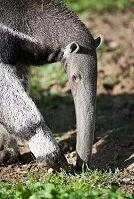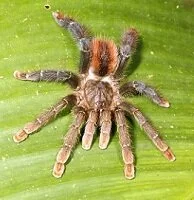
Anteater
The sea life in Guyana itself is fairly limited as the country boasts many rivers, but none of major significance and no real large lakes. This limits the freshwater fish life to catfish, pike, and a few others. Off the coast the animal life is much more impressive. While the waters have some mammals like whales, manatees, and dolphins, these waters are also home to thousands of fish and shellfish. Sharks, marlins, barracudas, grouper, snapper, mackerel, eels, rays, jellyfish, shrimp, crab, seahorses, starfish, and sea urchins all call these waters home.
These forests and coastline also attract hundreds of bird species every year. These range from woodland birds and rain forest birds to water fowls and others. Among these birds are sparrows, cardinals, parakeets, woodpeckers, hummingbirds, parrots, toucans, macaws, eagles, egrets, condors, frigate birds, pelicans, and pigeons among many more.

Tarantula
The reptilian, amphibian, and insect life in Guyana are also diverse. Many of these animals are spiders, including the tarantula and black widow, and snakes, including the rattlesnake. In or near some of the rivers the amphibian population spikes a bit as a number of frogs and lizards are present. The number of insects is quite substantial, including flies, mosquitos, butterflies, beetles, moths, ants, and more.
When it comes to native plant life, South America is home to many famous edible plants and these plants quickly spread throughout Guyana, South America, and beyond. The pineapple is from the region where Brazil and Uruguay meet while potatoes and tobacco originated in the Andes Mountains. A few others, including cacao trees (used to make chocolate), peanuts, and tomatoes are also from South America, although their actual origin is unknown. Peppers, both sweet and hot peppers are from Central America or northern South America while vanilla, avocado, papaya, and corn (maize) are likely from Central America itself. No matter each food's origin, what is known is that these foods spread throughout the continent and to the country of Guyana with the help of pre-historic people, animals, and winds. These people have had these foods for nearly as long as people have inhabited the region and each makes an important part of the people's diet and culture now and for thousands of years into the past.
More than just the famous plants already mentioned, Guyana hosts numerous other trees and plants. Pine trees, eucalyptus trees, cedar trees, mahogany trees, and cypress trees are all common.